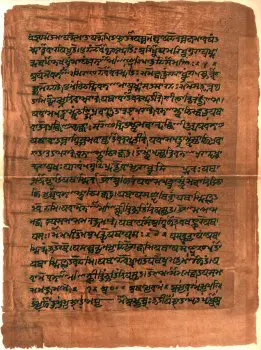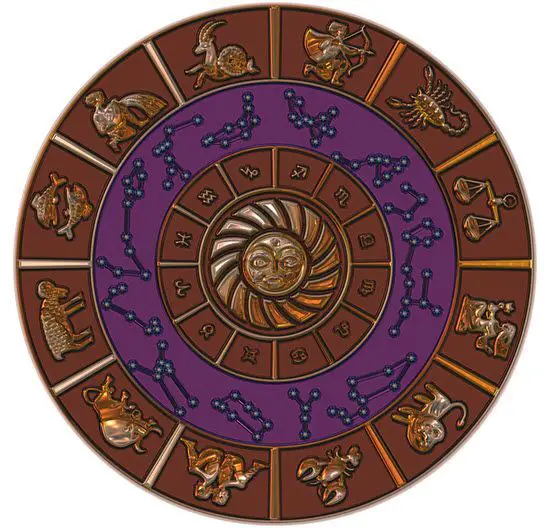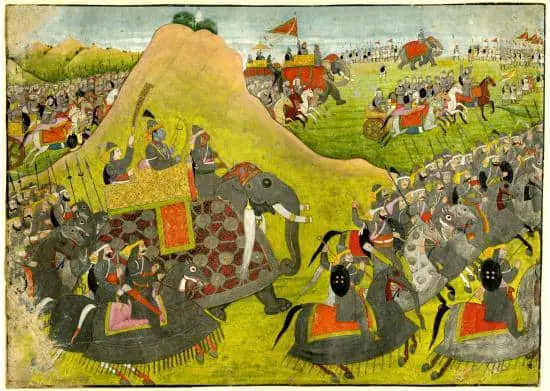The Vedas are the most ancient religious-spiritual scriptures of the world. They were transmitted orally from generation to generation over the millennia.
Sage Kṛiṣṇa-Dvaipāyana Vyāsa systematized, edited, and divided the Vedas into four parts known as Rig Veda, Yajur Veda, Sama Veda, and Atharva Veda. In this post, you will come to know all about Atharva Veda.
The Atharva Veda is regarded as the fourth Veda and is a late addition to the Vedic scriptures of Hinduism. It contains knowledge storehouse of “atharvāṇas,” i.e., the procedures for everyday life. The Atharva Veda has been written in Vedic Sanskrit and contains a collection of 730 hymns with about 6000 mantras.
The Atharva Veda has been called the “Veda of magical formulas.” It incorporates formulas for magic and even daily rituals for initiation into learning, marriage, and funerals. The Atharva Veda also includes royal rituals and the duties of the court priests. It has been estimated that the Atharva Veda was compiled about 1200 BC – 1000 BC.

The Atharva Veda is known by several other names such as:
- Atharvanaveda: The word Atharvan has been derived from ‘athar,’ which is regarded as an obsolete word for fire. It means ‘the priest of fire.’
So, Atharvan means the ancient sage who ‘brought down fire from heaven.’ In Hindu mythology, Atharvan has been described as the son of Brahma, who is credited to have introduced fire-rituals with soma and other materials.
- Atharvāñgi- rasa: Atharvan has been identified with Angiras and is also called as Atharvāṅgirasa.
- Angirasa: This Veda has been named after Sage Angirasa to whom various hymns of this Veda were revealed.
- Bhrgvañgirasa: This Veda has also been named after Sage Bhrigu, who revealed various hymns of this Veda.
- Brahmaveda: This Veda has been named as ‘Brahmaveda’ as it helps in the attainment of Brahma.
The Atharva Veda comes with some special features and covers the following topics in detail, such as:
- Rites for prolonging the life
- Diseases and their cure
- Penances
- Rites for fulfilling one’s desires
- Statecraft
- Trade and Commerce
- Propitiatory Rites
- Black Magic
In fact, Atharva Veda talks about high philosophical ideas that are similar in pattern with the Upanishads. Its literary style is much sophisticated. However, its sheer popularity made it the ‘scriptures of the masses.’
Originally, the Atharva Veda consisted of nine “shakhas” or branches of which only two are extant such as:
- Pippalada
- Saunaka
However, only ‘Saunaka’ is available in complete form. Moreover, the Veda has been divided into four ‘prapathakas’ that consist of 20 ‘kandas.’ Each ‘Kanda’ has been divided into ‘suktas,’ and these suktas contain mantras. The details have been shown below:
| Prapathakas | Kandas | Suktas | Mantras |
| I | 1 to 7 | 433 | 2030 |
| II | 8 to 12 | 45 | 1573 |
| III | 13 to 18 | 43 | 1063 |
| IV | 19 & 20 | 215 | 1411 |
| Total | 763 | 6077 |
The Kandas 19 & 20 are later additions to this Veda and are sometimes termed as ‘Khilakanda.’
The Subject matter of the Samhita in this Veda deals with eight topics that cover as follows:
- Bhaisajya: diseases, their causes, and cure
- Ayusya: supplications for longevity
- Paustika: welfare and worldly progress
- Abhicarika: destroy enemies who obstruct progress
- Prayascitta: expiatory rites
- Rajakarma: political system
- Brahmanya: Nature of Brahman or Absolute Truth
Table of Contents
Bhaisajya Suktas
These Suktas deal with health sciences. It talks about diseases, their causes, and cures. It contains prayers for health and longevity. Moreover, these suktas contain intimate knowledge of human anatomy.
It mentions several diseases and their cure, such as fever, leprosy, diabetes, skin disorders, fracture of bones, diseases of the heart, tuberculosis, etc. Apart from mentioning medicines and physical remedies, it also uses chants and charms in plenty.
So, the Atharveda is also considered as a precursor of Ayurveda (the science of health and longevity). Sometimes Ayurveda is listed as the subsidiary of the Atharva Veda. In fact, you can infer deep knowledge of the herbs and their medicinal properties from its mantras.
Ayusya Suktas
The Ayusya Suktas contain supplications for longevity. They are chanted on auspicious occasions such as Upanayana Sanskara (the ceremony of the sacred thread), Godana (the gifting of the cows), and more.
One of the Suktas expresses the need to wear “Rakshasutra” (it is a thread of protection) on the body for attaining longevity.
Paustika Suktas
Pusti means welfare as well as worldly progress. These Suktas have prayers to get the blessings of deities such as Maruts and Parjanya so that there could be good rainfall.
With good rainfall, there is plenty of crops and works such as agriculture, and trade flourishes well. The Paustika Sutras contain auspicious rites and are known as “Suklendrajala.”
The Abhicarika Suktas
The Abhicarika Sutras go on to destroy enemies who try to obstruct our progress. It is achieved by pleasing certain deities or spirits who help in fulfilling our wishes. This technique is known as “Yatu” or “Krtyu.” The number of these suktas is rather large.
This suktas help to destroy your enemies, including the lover of one’s spouse. You can get your desires fulfilled, mesmerize others, and even annihilate evil spirits. So, these suktas indicate the type of black magic rites.
Prayascitta Suktas
The Prayascitta Suktas go on to deal with expiatory rites that help to offset the evil effects that result from the wrong performance of religious rites. It also describes omens foreboding evils as well as the rites necessary to combat them.
Rajakarma Suktas
These suktas give an account of the political system that was prevalent during those days. For example, the king was elected by the people. Social as well as national problems were discussed in a “Samiti” that was a parliament of the people.
It states that the Raja Purohit (chief priest of the state) held an enviable place in the affairs of the state. It also contains prayers for victory in war. There are hymns that express devotion to the Motherland. All these are highly moving and poetic, as well.
The Brahmanya Suktas
These suktas describe the nature of Brahman, i.e., the Absolute Truth. The philosophical ideas discussed here are closely related to the Rig-Veda and the Upanishads. It states that the whole universe emerges from the God that is described as Kala, Skambha, Ucchista, and Vratya. He evolves the universe and is lord of the whole creation.
The Sun represents his power and is called as “Rohita” or the “Red-One.” He is related to God himself. The Absolute is also identified with the Atman. The word “Vratya” that has been described in this section represents Brahman, the Absolute.
Moreover, the Atharva Veda also contains cultural references giving an interesting picture of the society of its times. It states that the land in which the people lived extended from Gandhara (modern-day Afghanistan) to Magadha and Anga (present-day Bihar and Bengal).
The Varna system was well established. Kings were powerful, and people lived in harmony. Trade and commerce flourished through agriculture. Cows were worshiped, and “Godana” was considered a highly meritorious activity. Rajasuya sacrifice was prevalent among kings.
What Atharva Veda says?
The Atharva Veda is known as the “Veda of magical formulas.” It talks about magico-religious rites addressing superstitious anxiety and spells to remove maladies that are caused by demons.
It contains hymns dealing with charms, magic spells, and incantations. These hymn charms and spells were used for recovery from some illness or for having a long life of a loved one.
Some magic spells were meant for soldiers that were going to war so that they could defeat their enemy. Other magic spells were meant for anxious lovers that want to remove rivals, some were meant for getting success at a sporting event and even in economic activity, or for the bounty of cattle or crops.
On the whole, in the Atharva Veda, there is an anxious dread of the evil spirits and their magical powers. However, a significant portion of the Samhita text also deals with domestic rituals without magic or spells. You can even find theosophical speculations such as “all Vedic Gods are one.”
There are mantras and verses to treat a variety of ailments. For example, Atharva Veda contains prayers wishing a child to get over some sickness. There are praises of medicinal herbs and plants, suggesting the value of plants and herbs in ancient India.
Some verses relate to spells for obtaining a husband or wife or even the love of a woman. The Atharva Veda Samhita also contains hymns on metaphysical questions such as on the nature of existence, man, good and evil, heaven and hell. Some hymns are dedicated to gaining harmony and peace.
Lastly, the Atharva Veda has three primary Upanishads embedded within it, such as:
- Mundaka Upanishad, which contains mantras that are used for teaching and meditation on spiritual knowledge. It is often called as the Mantra Upanishad.
- Mandukya Upanishad which discusses the syllable Om and presents the theory of four states of consciousness together with the nature of Atman (Soul or Self).
- Prashna Upanishad deals with metaphysical questions, substantial philosophy, symbol Om and Moksha concept.
What Atharva mean?
“Atharva” has many meanings, such as:
- Atharva is the fourth Veda after Rig Veda, Yajur Veda, and Sama Veda
- Atharva is the other name for Sage Vashishta and Soma
- Atharva is the name of Lord Shiva
- Atharva means the name of Lord Brahma’s eldest son
- Atharva refers to the hymns of the Atharvan Veda
- Atharva is the name of the sage who is said to have composed the Atharvana Veda
- Atharva is also the name of Lord Ganesha
- Atharva is the priest who performs Hindu rituals according to the Atharvana Veda
- Atharva is the short name for one of the Upanishads of Shaivism known as “Atharvasika”
Atharva Veda Black Magic
The Atharva Veda is regarded as the storehouse of magic formulas and spells. It contains procedures for everyday life for counteracting diseases and calamities.
The Atharva Veda deals with hymns, chants, spells, and prayers for healing illnesses and prolonging life.
Atharva Veda is the oldest scripture in the world that deals with black magic and rituals for counteracting maladies and anxieties. The Atharva Veda contains mantras for ‘Vashikaran’ to control over the mind of any individual.
However, the language, intonation & pronunciation of the black magic spells that have been described in Atharva Veda are quite difficult. It requires elaborate rituals and complete knowledge of Sanskrit and spirituality.
That said, the Atharva Veda black magic spells are very powerful. They can help achieve the most difficult thing in your life, be it related to happiness, satisfaction, and success in life.
Well, that’s all in this post on Atharva Veda.
We hope that you found the post useful and interesting. We welcome your comments and suggestions.




